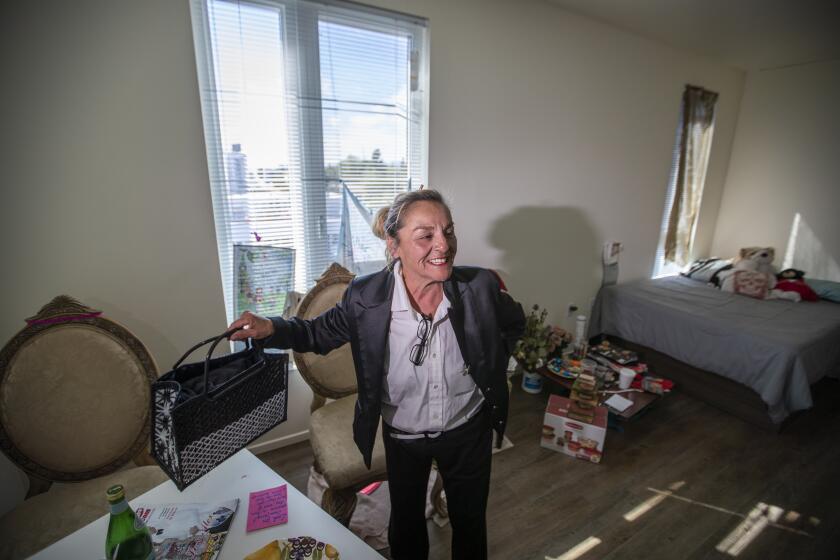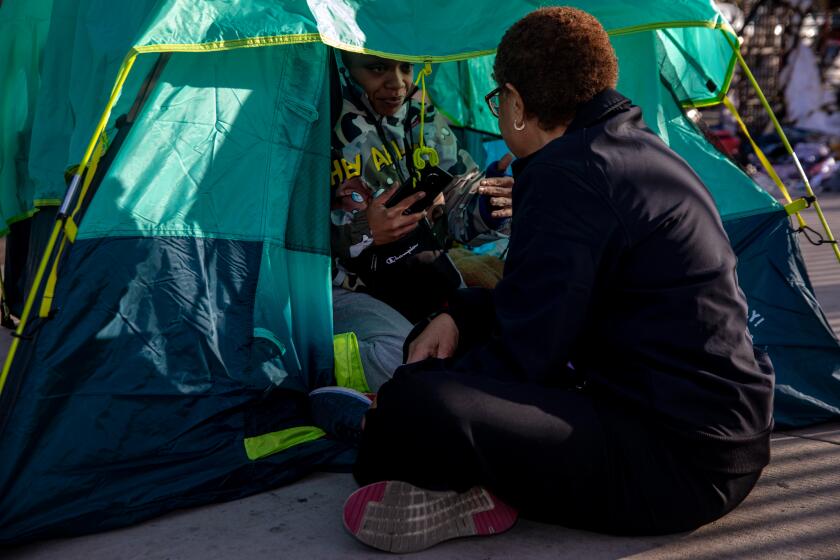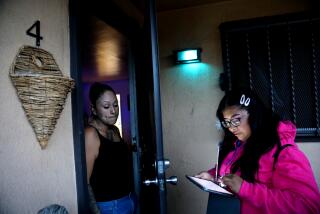Editorial: Homeless outreach workers are paid so little they risk losing their own housing

In Los Angeles, an outreach worker searches out homeless people, makes contact, earns the trust of people who have learned to trust few and shepherds them into temporary housing and eventually permanent housing. Sometimes, they are first responders for homeless people living on sidewalks, in parks and along beaches. They routinely carry naloxone to administer to homeless people who overdose on opioids, and they use it more and more often.
Outreach workers, along with social workers and case managers who help get homeless people services, benefits and housing are the people who toil on the front lines of the homelessness crisis that the city and county of Los Angeles have devoted billions to address. Their jobs are grueling. Thousands of them work for the nonprofit organizations that serve homeless people. But these front-line workers are paid so little that they face their own struggles to stay housed in the high-priced L.A. County market, according to a new study by the Rand Corp. commissioned by the nonprofit Social Justice Partners Los Angeles.
According to the study, most are paid between $40,000 and $60,000 a year. (Excluded from the survey were healthcare professionals working for these nonprofits who generally are offered more competitive pay, according to the study.)
Homeless people shouldn’t have to spend weeks collecting proof of their Social Security numbers and poverty before they can move into apartments.
But it takes a salary of $64,000 to afford a one-bedroom apartment in L.A. County without spending more than 30% of annual income in housing costs, according to the study, which uses the U.S. Department of Housing and Urban Development’s calculation of fair market rents. As a result, workers grapple with money worries as well as the stress of a job working with traumatized people. Burnout and turnover are high, the study says, citing a report that found that 53% of people doing this work had spent less than two years at their current employer in part because of worker burnout. According to the study, more than 200 nonprofits are doing homeless services work.
John Maceri, the chief executive of the homeless services nonprofit the People Concern, says that his younger, newer staff members tend to stay between 12 and 18 months. Longer tenured staff have been there five to seven years, he estimates, but they struggle the most with burnout. Turnover is not only bad for workers, it’s bad for their homeless clients who, according to the report, “have cycled through as many as six or seven case managers in Los Angeles County.” And both the majority of front-line workers as well as the people they serve are Black and brown.
Why the low pay? Nonprofit homeless service organizations that employ the front-line workers work mostly on contracts with government agencies — such as the Los Angeles Homeless Services Authority — to provide homeless services. Those contracts are funded with county, city, state or federal funds that nonprofits say are routinely underfunded.
So far, the Inside Safe initiative has temporarily housed 1,000 people. That’s impressive. The harder part will be getting them into permanent housing.
The total expenses to provide services at a shelter or housing development, including worker pay, can be $70 to $125 per bed (based on a 2021 estimate) depending on whether the clients have mental illnesses, substance abuse issues, chronic physical ailments or some combination thereof. Maceri says if his organization is providing services in an interim housing location, the bed rates on some contracts range from $50 to $68 a day. “The true costs are closer to $108 a night,” he said. “The expectation is that whatever it costs, you’ll figure it out.” As a result, organizations must fund-raise privately to attempt to make up the difference.
L.A. city and county agencies must stop exploiting people doing this indispensable humanitarian work by underpaying them. These workers should be paid enough to afford housing. Two years ago the editorial board wrote about how little homeless service workers get paid — even when the federal government mandated that pandemic relief dollars going to homelessness programs cover actual costs. As the new Rand study indicates, they are still underpaid. Va Lecia Adams Kellum, the new head of LAHSA, has said her agency is working with federal, state and local entities to develop funding models that will allow for higher pay.
The Rand study recommends, among other things, that government funders cover the full cost of services that an organization provides. It also suggests that workers get basic cost of living increases in their contracts.
Those are smart recommendations. Mayor Karen Bass is deeply invested in moving homeless people out of encampments and into housing. Part of that investment must involve fair pay for the workers who connect with homeless individuals and make that move toward housing happen.
More to Read
A cure for the common opinion
Get thought-provoking perspectives with our weekly newsletter.
You may occasionally receive promotional content from the Los Angeles Times.








